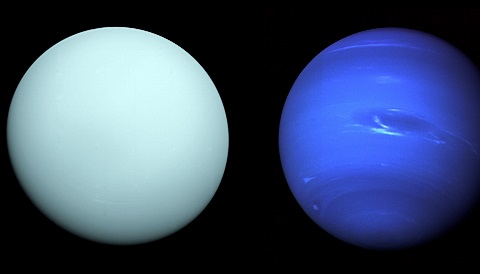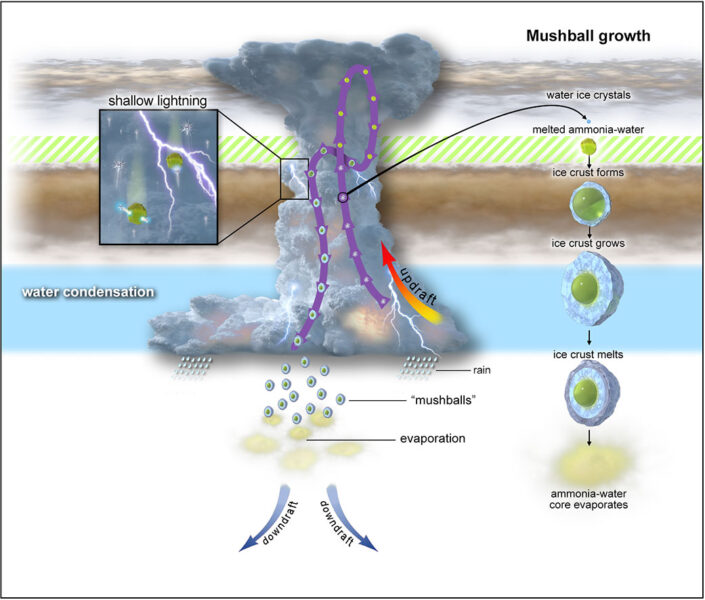“Mushballs,” first inferred to exist on Jupiter, may fall within the atmospheres of all the solar system’s giant planets.
Icy, ammonia-rich “mushballs” may plunge deep below the cloud bank in Jupiter's atmosphere. Now, a planetary scientist suggests this scenario might explain the surprisingly low levels of ammonia detected on Uranus and Neptune, too.

NASA / JPL / Caltech
Tristan Guillot (Côte d'Azur University, France), who shared the results at the virtual Europlanet Science Congress, says this may also help us understand the deep hydrogen-rich atmospheres of giant exoplanets.
Hailstorms on Jupiter
While astronomers had long observed an uneven distribution of ammonia on Jupiter, the key evidence for mushballs’ existence came from the Juno spacecraft's dramatic close-ups of violent thunderstorms on Jupiter. Juno revealed faint lightning flashes in regions where temperatures dip below -88ºC. Since lightning flashes require the presence of a liquid, and water is a solid at such low temperatures, the result initially baffled astronomers.
But what if the water is mixed with anti-freeze? Last year, Guillot and colleagues proposed that ammonia and water combined could remain slushy enough to allow lightning.
Ammonia is “the best antifreeze you can get,” says Guillot. Mixing one part ammonia to two parts water can keep the solution liquid down to -100ºC. Jupiter's atmosphere contains enough ammonia to form such a mixture, producing hail-like mushballs as big as the biggest terrestrial hailstones.

NASA / JPLCaltech / SwRI / CNRS
As shown in the above diagram, mushball formation starts when water ice crystallizes high in the atmosphere and starts drifting downwards. At lower levels, ammonia begins mixing with the water ice. Its antifreeze effect melts the water while more ice crystallizes, forming a solid outer shell that thickens as the mushball falls deeper down.
“During strong storms large ammonia-water . . . mushballs can form and fall to the deeper atmosphere,” reaching masses of a kilogram or more before they evaporate, says Guillot. The storms thus pull ammonia down from the upper atmosphere into the depths, while in Jupiter's calm equatorial region, where there are fewer storms, ammonia is more abundant.
Mushballs and Ice Giants
Recent infrared and radio observations have shown that ammonia is rare on Uranus and Neptune, too. At this week’s Europlanet Science Congress, Guillot noted that mushballs could explain this phenomenon, pulling ammonia deeper than expected on the ice giants.
The colder temperatures of Uranus’s and Neptune’s atmospheres favor ammonia’s antifreeze effect. Guillot showed that mushballs could exist over a broader range of conditions, and could therefore be even more efficient at drawing down ammonia, on the ice giants than on Jupiter.
“What may differ between Uranus and Neptune is the frequency and strength of storms,” he says. More abundant storms would pull more ammonia deeper. He notes that ammonia abundance on Saturn, as on Jupiter, varies with latitude.
Dave Stevenson (Caltech), who came up with the term “mushballs” and worked with Guillot on the Jupiter research but not on Uranus and Neptune, is cautious. He says they couldn't find any alternative to mushballs to explain the distribution of ammonia on Jupiter. However, without making a detailed analysis, he says, “In the case of Uranus and Neptune, the data admit alternatives.”
“We really need to go there,” Guillot says. Only a dedicated mission can probe deep into these ice-giant atmospheres. “Neptune and Uranus are a critical link between giant planets, like Jupiter and Saturn, and ice-giant exoplanets that we are discovering in the galaxy.”
 0
0









Comments
You must be logged in to post a comment.